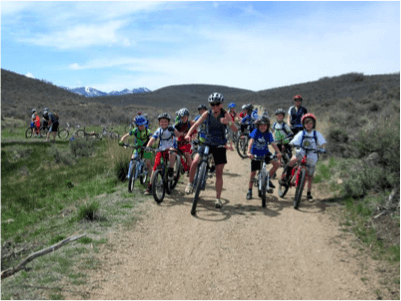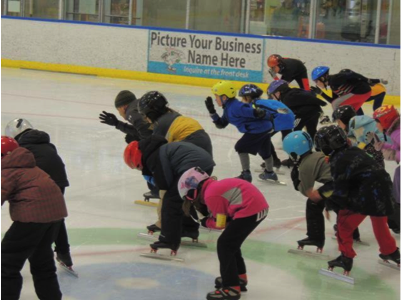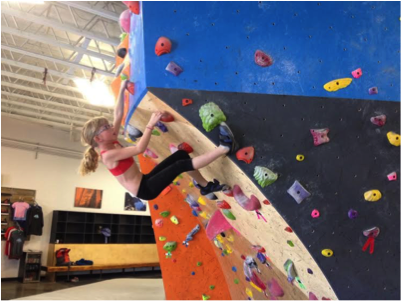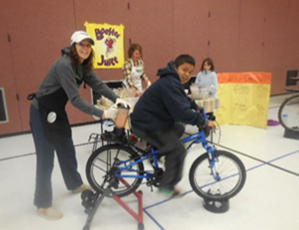As physical educators, we have many opportunities to improve the lives of thousands of kids who participate in our school physical education programs. If we are diligent in improving our programs by focusing on lifelong health and physical activity with our students, we can all do our part in succeeding with “50 Million Strong.”

What’s My Number?
At McPolin Elementary School, my number is 425, preschool through 5th graders. I work directly with the Lifestyles Counselor to provide quality instruction at our Title 1 school. We are a Spanish Dual-Immersion school. Although we live in an affluent resort town, 50 % of our students are on free or reduced lunch. We have Federal funding for free breakfast for all students and a healthy snack every day (See EATS program below). We have an Afterschool Enrichment Program for at-risk students, that provides a snack, a physical activity, computer, and homework sessions.
Some students go home to care for their younger siblings at night while parents work in a service job. Many have multiple families living in the same apartment. The challenge for me is to help provide a variety of opportunities for physical activities at school and in the community. I work closely with community agencies to provide access to programs that will benefit ALL of our population. The adage “it takes a village to raise a child,” definitely applies to our town. Many residents have stepped forward to benefit our diverse population.
Advice to physical educators who want to succeed with 50 Million Strong by 2029
- This year, step out of your comfort zone and add a new or expanded unit involving one of the key fitness components: flexibility, muscular strength, muscular endurance, or cardiovascular fitness. Focus the whole lesson on that component: Explain, show visuals, demonstrate, practice, provide activity to reinforce, check for understanding.
- Share your successes! Go to local, regional, or national conferences. Share what you learned with your teaching colleagues who couldn’t attend. Incorporate one or two activities you learned into your curriculum.
- Get to know the people who live in your community: parents, businesses, and media. Volunteer in a non-profit agency. The more people you know the more support you will get for your school.
- Enlist parents and community members to assist you in developing a school wide healthy lifestyle program to benefit your students.
I have taught in 2 elementary schools for 32 years, 22 years in Park City, Utah. Over the years, I have seen a definite decline in physical fitness, as well as an increase in overweight and obese students. I attribute this to many changes in society: advent of increased computer and video game use, economic stress in families, choosing fast food or junk food over healthy food, and limited access to physical activities for low income families. Below are a few of the programs I have organized at our school and community agencies who over the years had a huge effect on changing the lives of children in our community.
Gold Medal Mile
We have been running this program at McPolin every spring for 8 years. I mark off a running course on our field area. At lunch recess students run the course, collecting a popsicle stick from a recess aide for every lap (12 laps equal one mile). The aide punches a card for every mile run by the student. In PE class, students wear pedometers and record at least 2,000 steps for their mile each class period. Rubber bracelets are awarded to students who have completed 5, 10, 20, 30, 40, 50, 60 miles. I take their picture and post it on the bulletin board in the hall. The first few years we gave out small feet on a chain. Students wore them proudly around their neck. We have had class competitions and mapped our mileage across the United Stated for incentives. Along with this program, parents run a self-esteem program called “Girls on the Run.” After a few months of practice the girls run in a statewide 5K in Salt Lake with hundreds of girls and their parents.
4th & 5th Grade District Track Meets
This year is our 20th year for this annual event. All the elementary school Physical Education teachers run a district track meet for 4th & 5th grades.. After spring break, we practice running the 50m, 100m, 200m, 400m and 50m low hurdles at our own schools. We also practice softball throw, Frisbee throw, long jump, foxtail throw, and football throw for accuracy as our field events. We put teams of 4 students together for 4x25m, 4x50m, 4x100m, 4x200m, & 4x400m relays. We meet at the high school for a morning of competition and fun! We give out ribbons for 5th grade on one day and just run for fun on the 4th grade day. None of our schools have a track, so students are excited to race on a real track. We enlist parents to help run the event.
Jump/Hoops for Heart
Students at McPolin can’t wait to participate in these programs. I do Jump Rope for Heart for grades k-3 and Hoops for Heart for grades 4-5. In 20 years, our kick-off assemblies have included professional sports players, heart doctors, students and local survivors, college mascots, and teacher jump-offs and shoot-offs. Fifth graders are peer tutors to teach the kindergarten students how to jump. Students in grades 2-5 record how long they can jump without a miss in the McPolin Jumper’s Club. I give a jump rope to all new and struggling students to practice on recess. I also assign a student peer tutor to help them. At the end of the unit, each grade has a jump-off with the beginning and intermediate skills.
The Girl’s & Boy’s Varsity Basketball coaches offer students a free basketball skills clinic after school. Students are encouraged to join a Junior Jazz Basketball Team through the Basin Recreation department. They offer scholarships for free and reduced lunch students to cover the $10 for the season. It also includes a uniform. The recreation department’s “Let’s Play” program also includes youth soccer, softball, baseball, flag football, volleyball and a variety of sports camps over the summer and every vacation break.
Youth Sports Alliance
The mission of the Youth Sports Alliance is to support winter and summer sports activities for the youth in our community. They promote good sportsmanship and healthy lifestyles through participation, education and competition. The Alliance encourages all athletes to adopt and embrace the following core values: sportsmanship, perseverance, optimism, respect, and teamwork. They solicit donations and grants from local sporting goods businesses and private individuals to run a program for elementary school students called “Get Out and Play.” Their goal is for every elementary student to participate in one of their programs every Friday afternoon. They provide 5 weeks of beginner instruction in ice skating, skiing, snowboarding, cross country skiing, ski jumping, mountain biking, and bouldering. The scholarship cost to free & reduced lunch students is $50. They also provide the equipment and the clothing at no cost. If students like the activity, they are encouraged to join a club and compete at a higher level. Scholarships are also available for club fees. For more information visit the Youth Sport Alliance web site.


EATS
Physical activity and good nutrition go hand-in-hand for the overall health of our children. While PE teachers focus heavily on getting kids to move, the energy gained from good eating habits contributes to children’s ability to be active and mature into healthier adults. Therefore, teaching about good eating habits fits perfectly with PE curriculum.
In the Park City community, a non-profit organization called EATS – Eat Awesome Things at Schools – helps educate students in our school district about healthy food habits. This grass-roots organization started in 2013 when community members approached the Child Nutrition Services Director to learn more about the school food program. They learned that positive changes were being made to the school food offerings but resources were lacking on education programs.
EATS Park City formed to fill that gap, rallying parents and community members to volunteer for in-school programs. Quickly, the organizers saw the need to become a non-profit organization so that programs could grow and become sustainable district-wide, and the school food offerings could continue to improve. EATS mission evolved to “ensuring every student has access to fresh, nutritious, appealing food and opportunities to develop lifelong positive and healthy food habits” with a vision of “a significantly healthier generation.”
To achieve their mission, EATS developed and promoted key health education programs:
- Taste Tests – The first step in kids eating healthy is getting them to TRY healthy food. EATS volunteers entice kids to try locally sourced, healthy foods monthly during lunchtime, while providing education materials in the form of posters, teacher flyers, and PTO newsletter inserts including recipes. Kids receive an “I TRIED IT” hand stamp to show others and invoke dinner table conversation at home. Local farmers are thrilled to supply their produce to schools and meet parents at the Farmers Market who buy food their kids tasted at school. Students at McPolin have tried such palate-stretchers as asparagus, brussel sprouts, spaghetti squash, and roasted pumpkin, along with easier sells such as hummus, pickles, tomatoes and honey. Parent comments attest to results: “My son would never eat tomatoes. But after the taste test, he begged me to buy them!”
- Cooking Classes – In our fast-food world, understanding what goes into our food can get lost. By teaching kids how to cook, they will be able to feed themselves without relying on others. Students in the After-School program at McPolin participate in hands-on cooking classes to create delicious food from the monthly Taste Test food item. Local chefs volunteer their time to teach students to chop, grate, saute and blend ingredients to create something they are proud to taste and share. In addition, core curriculum learning takes place serendipitously through measurements (math), cooking (chemistry) and use of tools (technology). Pumpkin waffles with homemade blackberry jam, asparagus soup, beet pancakes and chicken quesadillas are just a few of the great creations they made in the program.
- School Gardens – Taking food one step further back in the food chain, school gardens teach that food comes from the ground, not the grocery store. Not only can school gardens introduce students to healthy food, they can learn about biology in plants and the human body, write about life from an ant’s perspective, graph growth patterns, and learn how to work together. Don’t worry if you have a short growing season, indoor gardens proliferate and are cost-effective alternatives. McPolin elementary has a Tower Garden in 3rd grade Spanish immersion where they learn plant names in both languages and watch their seeds grow into edible plants.
- Snack Program – Being a Title 1 school, McPolin was awarded a federal grant to fund a fruit/vegetable snack program. Students are offered interesting snacks ranging from red pears to pomegranates to introduce them to new produce, along with an education piece distributed by the teachers. The funding allowed for snacks two days per week. However, PTO parents saw the importance of the healthy snacks and set up a complementary snack program for another two days per week. The PTO partnered with the local grocery store that provided the snack at cost, prepared the food for distribution and washed the delivery bins. A PTO volunteer is responsible for pick-up and delivery of the snack. The PTO’s program costs a fraction of the cost of the federal program and utilizes local produce, community partnership and parent involvement. Both snack programs are excellent for the students, and show there are creative solutions when passionate people get involved.

- Morning Meals Matter – Being the most important meal of the day, breakfast is offered to ALL students at McPolin free of charge. Last year, EATS conducted a month-long education and promotional campaign to increase school breakfast participation. Each day, a breakfast tray was displayed with the healthiest choices and students were told why these were better choices. Eggs with protein to build muscles versus Tootie Frootie cereal with empty sugar calories that wouldn’t last until lunch. A participation contest was held with the winning grade earning extra recess time. Weekly prize bags containing an exotic fruit were awarded based on making healthy choices. EATS educators attended the Healthy Lifestyle Classes and did grade-based activities teaching about breakfast choices. And several fun activities occurred during breakfast time to bring energy and fun to the cafeteria including homemade healthy muffins from local sources, Halloween fun with pumpkin tangerines and Blender Bikes making healthy smoothies. The result was a 22% increase in breakfast participation rates that sustained throughout the year.For more information on EATS Park City and how you can start programs like these are your school, visit www.eatsparkcity.org or contact Ann Bloomquist, President/Co-Founder at eatspc@gmail.com.
Running with Ed!
In 2009, at the height of the recession, the Park City Education Foundation (PCEF) was looking for a new way to raise funds and engage the entire community. The PCEF, as the non-profit fundraising partner of the Park City School District, knew that private support was becoming more critical to the success of every student in public schools. Yet, no one wanted to do another Gala or sell more chocolate or wrapping paper!
Thus, Running with Ed (RWE), a relay race fundraiser was born! Teams of five to 10 people run around a 10 leg, 40-mile course, with stops at each of the district’s seven schools and a few other prominent local landmarks such as the ski resorts and the city park. Each team member runs 1 to 2 legs, and each exchange stop has a school party, with a big Finish Party at the end featuring a free lunch, music, and activities for the kids. Prizes are given for best team theme and costumes.
And who is the ‘Ed’ in Running with Ed? It’s EDUCATION, of course!
Funds are raised through registration fees, sponsorships, and team fundraising. Teachers and students are given a price break as an extra incentive to run. And some legs are shorter than a 5K, ensuring that almost anyone can take part in this healthy activity.
In 2010, our first year, we had 80 teams, including 10 teacher teams, and we raised about $40,000. This past year, in 2015, almost 200 teams participated, including over 25 teacher and teacher/student teams, and we raised over $250,000!
The entire community has embraced the race, which is a great ‘Celebration of Education.’ We promote it to teachers, students, and their families as a great way to ‘get active and give back!’ Each school in our district takes part, with competitions between schools to see who has the highest participation of students and teachers, as well as the best exchange stop.
Today, many of our elementary schools promote RWE in their PE classes, encouraging their students to take part. The PE teachers work hand in hand with the teachers, school administration, and the PTO for the school costume and exchange theme, which makes ‘getting active and giving back’ so much fun. Kids almost don’t realize they are exercising! And the teachers love taking part because it is truly a celebration of all they do for our kids. Teachers are cheered on at each stop, and they know all the dollars raised will come back to their classrooms in the form of teacher-requested grants.

For more information on Running with Ed visit www.pcef4kids.org
